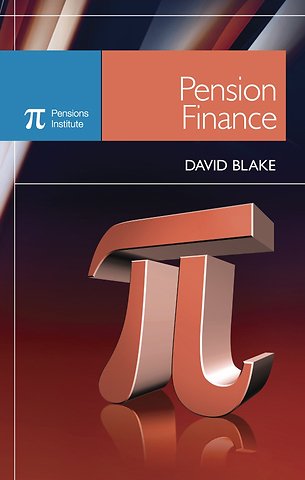Pension Finance
Samenvatting
This book provides a secure grounding in the theory and practice of finance insofar as it deals with pension matters. By using it, the reader will understand the various types of investment assets;
∗ the allocation of personal wealth to different asset classes
∗ corporate pension finance
∗ the financial aspects of defined contribution pension plans during both the accumulation and distribution phases
∗ the financial aspects of defined benefit pension plans
∗ the role of pension funds and pension fund management
∗ pension fund performance measurement and attribution
∗ risk management in pension funds
Specificaties
Inhoudsopgave
<p>1 Investment Assets.Held by Pension Funds.</p>
<p>1.1 Money–market securities.</p>
<p>1.2 Bonds and loans.</p>
<p>1.3 Shares.</p>
<p>1.4 Collective investment vehicles.</p>
<p>1.5 Real assets.</p>
<p>1.6 Derivatives.</p>
<p>1.7 Alternative investments.</p>
<p>1.8 Socially responsible investment.</p>
<p>1.9 Global custody.</p>
<p>1.10 Different asset characteristics and uses.</p>
<p>1.11 Conclusion.</p>
<p>Questions.</p>
<p>References.</p>
<p>Appendix A: Standard deviation, value–at–risk and correlation.</p>
<p>2 Personal Finance: The Allocation of Personal Wealth to Different Asset Classes.</p>
<p>2.1 Introduction.</p>
<p>2.2 Modelling the allocation of personal wealth to different asset classes.</p>
<p>2.3 Conclusion.</p>
<p>Questions.</p>
<p>References.</p>
<p>3 Corporate Pension Finance.</p>
<p>3.1 The valuation of pension liabilities: Differences between the actuarial and economic approaches.</p>
<p>3.2 Pensions and the company balance sheet: Differences between the accounting and economic approaches.</p>
<p>3.3 The asset allocation of the pension fund.</p>
<p>3.4 The relationship between the pension fund and the sponsoring company s profitability, credit rating and share price.</p>
<p>3.5 Conclusion.</p>
<p>Questions.</p>
<p>References.</p>
<p>4 Defined Contribution Pension Schemes The Accumulation Phase.</p>
<p>4.1 The optimal design of DC schemes during the accumulation phase.</p>
<p>4.2 Charges.</p>
<p>4.3 Persistency.</p>
<p>4.4 Conclusions.</p>
<p>Questions.</p>
<p>Appendix A: Charges.</p>
<p>References.</p>
<p>5 Defined Contribution Pension Schemes The Distribution Phase.</p>
<p>5.1 Annuities.</p>
<p>5.2 The optimal design of DC schemes during the distribution phase.</p>
<p>5.3 Conclusion.</p>
<p>Questions.</p>
<p>References.</p>
<p>6 Defined Benefit Pension Schemes.</p>
<p>6.1 Types of defined benefit scheme.</p>
<p>6.2 Defined benefit liabilities.</p>
<p>6.3 The option composition of pension schemes.</p>
<p>6.4 Valuing the options.</p>
<p>6.5 The pension scheme preferences of members, sponsors and fund managers.</p>
<p>6.6 Conclusion.</p>
<p>Questions.</p>
<p>References.</p>
<p>7 Pension Fund Management.</p>
<p>7.1 The role of a pension fund.</p>
<p>7.2 The functions of a pension fund manager.</p>
<p>7.3 Fund management styles.</p>
<p>7.4 Different fund management strategies for defined benefit and defined contribution schemes.</p>
<p>7.5 The fund manager s relationship with the trustees.</p>
<p>7.6 Passive fund management.</p>
<p>7.7 Active fund management.</p>
<p>7.8 Asset–liability management.</p>
<p>7.9 The Myners review of institutional investment.</p>
<p>7.10 Conclusion.</p>
<p>Questions.</p>
<p>References.</p>
<p>Appendix A: Investment–objectives questionnaire.</p>
<p>Appendix B: Derivation of the optimal contribution rate and asset allocation in a defined benefit pension fund.</p>
<p>8 Pension Fund Performance Measurement and Attribution.</p>
<p>8.1 Ex–post returns.</p>
<p>8.2 Benchmarks of comparison for actively managed funds.</p>
<p>8.3 Risk–adjusted measure of portfolio performance for actively managed funds.</p>
<p>8.4 Performance attribution for actively managed funds.</p>
<p>8.5 Liability–driven performance attribution.</p>
<p>8.6 Realised investment performance.</p>
<p>8.7 Performance–related fund management fees.</p>
<p>8.8 How frequently should fund managers be assessed?.</p>
<p>8.9 Conclusions.</p>
<p>Questions.</p>
<p>References.</p>
<p>Appendix A: Deriving the power function.</p>
<p>9 Risk Management in Pension Funds.</p>
<p>9.1 The objective of hedging.</p>
<p>9.2 Hedging with futures.</p>
<p>9.3 Hedging with options.</p>
<p>9.4 Hedging with swaps.</p>
<p>9.5 Hedging longevity risk.</p>
<p>9.6 Conclusion.</p>
<p>Questions.</p>
<p>References.</p>
<p>10 Pension Fund Insurance.</p>
<p>10.1 The Pension Protection Fund.</p>
<p>10.2 What the Pension Protection Fund can learn from other financial institutions and compensation schemes.</p>
<p>10.3 The risks facing the PPF.</p>
<p>10.4 Dealing with these risks.</p>
<p>10.5 Conclusion.</p>
<p>Questions.</p>
<p>References.</p>
<p>Appendix A: The Marcus (1987) and Vanderhei (1990) models.</p>
<p>Appendix A: Financial Arithmetic.</p>
<p>Appendix B: Yields and Yields Curves.</p>
<p>Appendix C: Duration and Convexity.</p>
<p>Index.</p>
Anderen die dit kochten, kochten ook
Net verschenen
Rubrieken
- aanbestedingsrecht
- aansprakelijkheids- en verzekeringsrecht
- accountancy
- algemeen juridisch
- arbeidsrecht
- bank- en effectenrecht
- bestuursrecht
- bouwrecht
- burgerlijk recht en procesrecht
- europees-internationaal recht
- fiscaal recht
- gezondheidsrecht
- insolventierecht
- intellectuele eigendom en ict-recht
- management
- mens en maatschappij
- milieu- en omgevingsrecht
- notarieel recht
- ondernemingsrecht
- pensioenrecht
- personen- en familierecht
- sociale zekerheidsrecht
- staatsrecht
- strafrecht en criminologie
- vastgoed- en huurrecht
- vreemdelingenrecht







